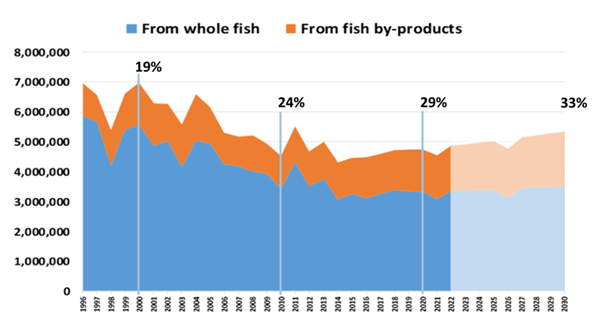There was once a time when nearly all the worlds fishmeal and fishoil supplies were obtained from forage fisheries. These forage fisheries are those that have a very limited direct food market for humans and are based on using high-abundance, low-trophic level fish with annual recruitment cycles. Still to this day, some of these fisheries, like the Peruvian Anchoveta and the North Atlantic Capelin fisheries are among the largest single-species fisheries on earth. However, the introduction of strict fishery quotas in the 1990’s and 2000’s led to a reduction in the volumes of forage fish being harvested in many key fisheries across the world. Despite this reduction in fishing pressure in many of those fisheries, it has been widely recognised that we are at the limits of responsible global supply of forage fish.
Given that we are working with a finite supply of forage fish, there has been an increasing focus on the use of by-products from the fish caught for direct human consumption (DHC) to provide the raw material biomass for fishmeal and fishoil production. Increasingly contributing to the story in providing additional biomass input are the by-products from the aquaculture industry itself. Indeed, today this use of by-products represents one of the best bio-circularity stories around in terms of capturing the full-value of animal production/capture in our food chain. Over the past twenty years the volume of by-product fishmeals has grown from 1.2M tonnes (about 19% of total fishmeal production) to the present day where it now represents more than 1.5M tonnes (about 29% of total fishmeal production) (Figure 1).
While the majority (69%) of by-product fishmeals still come from biomass obtained from wild-fisheries sourcing fish for DHC, the supply of biomass from aquaculture is rapidly catching up. Presently three major aquaculture sectors contribute most of the aquaculture by-product fishmeal, though undoubtedly there are more that we are yet to account for. Salmon aquaculture by-products are the largest contributor, followed by Pangasius by-products and then tilapia. Further inclusion of by-products from shrimp aquaculture in these estimates would certainly bolster these figures, and we know a substantial volume of this product exists but capturing data from this sector has proven more difficult.
Looking to the future, we see positive signs. There is improving management of many global fisheries throughout the world. Cuts to total allowable catches (TACs) in the early 2000’s are now reaping benefits in terms of stabilising fishery biomasses in many of the large forage fisheries around the world. Combined with the increased use of third-party sustainability certification systems, like MarinTrust and MSC, market forces are being used to drive responsible resource use across the sector. However, despite these positive signs it is unlikely that we will see total forage fishery catch exceed much more than 16 M tonnes a year into the future. This means that fishmeal and fishoil yields from that resource are constrained to about 4 M tonnes a year.
However, those same fishery improvements are extending beyond the forage fisheries into other large DHC fisheries. This of course also means that with improvements in fishery sustainability for DHC we are also improving our biomass base for the production of by-product fishmeals. Based on FAO estimates for fishery yields in 2050 of 80 M tonnes, we suggest that of the 64 M tonnes that is predicted to be caught for DHC, that we should be able repurpose up to 33% of that biomass as by-products (20 M tonnes) producing another 5 M tonnes of fishmeal and oil. We are presently processing almost 5 M tonnes of biomass (~1.25 M tonnes of fishmeal and oil), yet there are still many more processors around the world where we could repurpose more of this valuable resource.
Aquaculture is another dimension to add to this story. Over the past twenty years we have seen unprecedented growth in this food production sector and predictions are for this to continue. Based on FAO estimates for aquaculture production in 2050 we could see aquaculture production reach 140 M tonnes. Even if we take a conservative view of only being able repurpose up to 15% of that biomass as by-products (~20 M tonnes) by 2050, then that would contribute another 5 M tonnes of fishmeal and oil. Presently in 2020 we already repurpose more than 3 M tonnes of aquaculture by-product and there is still much more that could be done to improve the supply and use of these products. But one thing is for certain, so long as we keep fishing sustainably, and growing fish in aquaculture for human food, then we will always have fishmeal and fishoil available as strategic feed resources.

Figure 1. Global fishmeal production by raw material input origin 1996 – 2030 estimates.








